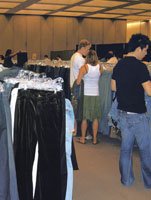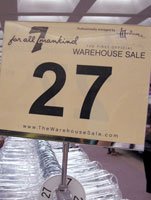Competition Fierce in Discount-Sales Business
Inside the spacious Los Angeles Convention Center, thousands of premium-denim jeans hang as far as the eye can see—enough jeans to fill several retail stores end to end.
The crowd sifting through the 30,000 pieces of fashionable 7 For All Mankind merchandise is diverse—from older boomers to younger consumers—and united by one thing: snapping up bargain apparel.
Sylvia Jeong is rummaging through a rack of premium-denim jeans, hunting for the right fit and the right wash. “If you go to the Nordstrom Rack, they have the older styles. This is more up to date,” said the thrifty shopper with a few pairs of jeans thrown over her arm. She intended to buy two or three pairs of denim pants and maybe a few shorts at a recent The Warehouse Sale before heading over to the huge showroom sample sales at the California Market Center, located a few blocks away in downtown Los Angeles.
With retailers and manufacturers floating in excess inventory, these kinds of mass-merchandise sales have become more popular with consumers on the prowl for goods marked at least 50 percent to 80 percent off.
But even for the purveyors of discount goods, times are tougher. “People who used to buy three carts full of clothing are now buying only two or three pairs of jeans,” said Jimmy Tung, chief executive and founder of The Warehouse Sale in Burbank, Calif., one of the largest premium-denim discount sales events in the country. “We started to see a slowdown at the end of 2008.”
Tung estimates his 2009 sales will be down 25 percent from last year, although he did not give specific numbers.
The fashion industry is no stranger to bargain-basement sales events. The Saturday Sale has been operating for more than 20 years in the two basement halls of the California Market Center, where excess inventory, late shipments, samples and cancelled orders find a home. Most items sell for $10 to $30.
While customer attendance has increased 15 percent in the last three years, revenues are pretty much flat this year compared with last year.
One of the challenges for these offline sales events is the bevy of online sites that cater to penny pinchers and parsimonious consumers. Bluefly and Overstock have been around for years. But there are also relative newcomers, such as Top Button, HauteLook and Rue La La. And that is making offline discount events think hard about holding big-box blowouts where a 100,000-square-foot space is rented for the weekend and scores of people are hired to set up and maintain the no-frills sale.
Billion Dollar Babes in Hollywood used to be totally offline until Onestop Internet in Rancho Dominguez, Calif., purchased it late last year. Billion Dollar Babes, founded in 2001, elevated shopping to the next level.
It wasn’t just a plain, cavernous hall filled with racks of clothing and an en masse dressing room but a social-networking event with flowing cocktails, swag bags and beauty bars. Since Onestop purchased Billion Dollar Babes, shopping and partying have been limited to clicking on Billion Dollar Babes’ Web site (www.billiondollarbabes.com).
Onestop, which has built and maintains Internet sites for more than 30 apparel brands, believes the Web is the way to reach more people, said John Tomich, a partner in Onestop. But not all shoppers see it his way.
So, on Nov. 6–7, Billion Dollar Babes will resurface on land to stage a shopping extravaganza at the Petersen Automotive Museum on Wilshire Boulevard in Los Angeles.
“I think on the Internet, you are not bound by geography,” said Tomich, explaining the advantages of selling online. “The amount of people you can get to a site is more than you can get in one day for an event like the one Jimmy does at The Warehouse Sale. We can do five sales a week and have 5,000 visitors come from all over.”
But die-hard Billion Dollar Babes started clamoring for a return to the cocktail-swilling and makeup-infusing event. “Women who had gone to it in the past said, ’We love the Billion Dollar Babes,’” Tomich said. “And the offline is a way for brands to connect with the customer in a tactile way.”
So Onestop is planning to do eight big multi-line sample sale events next year in Los Angeles and New York to keep the partying vibe alive.
Meanwhile, The Warehouse Sale people are going strong with their schedule to produce a total of about 65 close-out sales this year in metropolitan areas such as Atlanta, Las Vegas, Dallas, San Francisco and Seattle. Last year, they conducted about 50 sales.
The Warehouse Sale started out as only a premium-denim discount sale. “At the time, there was a high demand for premium denim, but it was almost impossible to find premium denim to sell,” said Tung, who started getting acquainted with the big-name premium-denim manufacturers.
The Warehouse Sale’s first solo sale was in June 2005 at the Metropolitan Hotel (now shuttered) on Sunset Boulevard with labels such as Chip & Pepper, Blue Cult, 575, Citizens of Humanity and 7 For All Mankind. “We had a huge turnout. The space was only 2,500 square feet. We had 1,500 people who had to wait two hours to get in,” Tung recalled, noting they sold practically all 2,500 pairs of jeans. “Then the prices were 30 percent to 50 percent off. Back then, to be 30 percent off for premium denim was amazing.”
Now, Tung said, consumers won’t even budge until jeans are 70 percent to 90 percent off because retailers such as Macy’s, Nordstrom Rack and Ross Dress For Less have been discounting so heavily. Also, denim manufacturers are managing their production and inventory more acutely, which has forced The Warehouse Sale to branch out to T-shirts, dresses and other goods.
Yet, not to be left out in the Internet cold, Tung has decided to launch an online store on his company’s Web site, www.thewarehousesale.com, in early November to keep up with the competition. “We already have almost 650,000 people registered on our site,” Tung said. “We might as well take advantage of that. But there are so many people online, I am starting to ask if there is room for one more.”
























